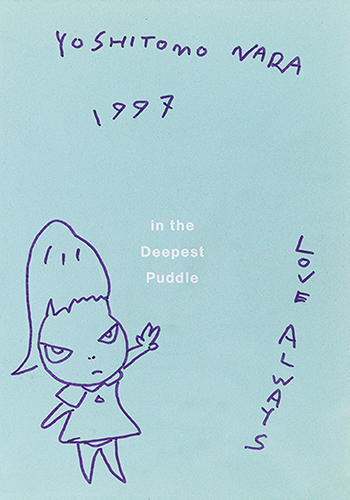PROVENANCE:
Kadokawa Shoten Yoshitomo Nara: in the Deepest Puddle Signing Event, Japan, 1997
Private collection, Japan
Private collection, Taiwan
Catalogue Note:
LOVE ALWAYS
Yoshimoto Nara, the Japanese artist who prefers to a solitary affair, have become the household names in areas such as cross-genre fusion, pop culture, fashion, literature, and commercial art. “All my paintings are portraits of my own inner self, representing a dialogue with my personality. ” There can be no doubt that this artist, unwilling as he is to grow up, continues to live a richer and deeper life than many adults.
Nara was born in Hirosaki, a village located in the northern prefecture of Aomori, Japan. After obtaining a Masters in Fine Arts from Aichi Prefectural University of Fine Arts and Music in Nagoya, Japan in 1987, Nara moved to Germany to study at the Kunstakademie Düsseldorf, from which he graduated in 1993. Nara ended up living in Germany for 12 years. For the first six of these, from 1988 to 1994, he studied at the Kunstakademie Düsseldorf, while spending the later six (1994- 2000) setting up a studio and working as a professional artist in Cologne. Since he was unable to communicate fluently in German, he again had to resort to using his art as a medium for conveying his meaning. Just as he did when a little boy, he spoke to people through his paintings, at the same time raising his awareness of his own identity and existence. During those years he also began to write a diary, not as some kind of official record, but entirely for the purpose of a dialogue with his inner self. Living in what for him was a rather remote and secluded environment, his sense of loneliness prompted him to start a fresh examination of his childhood years. The solitude he had felt in the wide lands of his native Aomori metamorphosed into the vast spaces of his compositions, into which his protagonists are placed with a delicate sense for contrast, balance, and proportion. In Germany, Nara began to gradually develop his trademark artistic style, with flat, simplified backgrounds and a firm focus on the children or animals that are the usual subjects of his paintings. The artist seems to have oscillated between feelings of isolation and happiness when reflecting on his life, and his youth in particular. At first, sadness and melancholy appear to have dominated his mood, and the rawness of his emotions is clearly mirrored in the looks of his protagonists, especially the expressions in their eyes, which range from challenging and provocative to apathetic, callous, or downright evil.
Deep down inside, the artist’s greatest wish is to be as a child forever. As long as he can paint, he can be. When he was young, Nara’s mother would often give him promotional flyers and handouts. The backs of these, which usually had nothing printed on them, provided the perfect drawing paper for Nara, allowing him to paint or even just doodle away to his heart’s content. To this day, he still enjoys doodling and scribbling just for fun. It is not surprising, then, that his work radiates a childlike charm, and that the artist often comes off as less than a grownup. His children with wide eyes and sad-faced white doggies betray a deep-seated fragility and vulnerability. In the documentary “Traveling with Yoshitomo Nara” there is a passage where the voiceover says, “Somewhere hidden inside everybody’s heart there is a lonely, sensitive child trying very hard not to cry. ” When we look into the stubborn and willful eyes of Nara’s protagonists, we involuntarily recall our own “childishness,” and are able to identify with the feelings conveyed by the artist’s characters.
